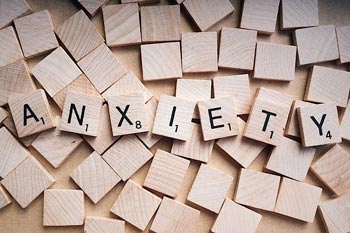Calming Anxiety: How to Respond When Worry Takes Over
by Annabel Jiran
December 2021
Worry is a normal part of life. However, worrying can easily become overwhelming and reach a point where it does more harm than good, leading to a medical condition called anxiety disorder. Health researchers have discovered that one in three Americans will have an anxiety disorder at some point during their life. Because the condition is so common, understanding what causes anxiety and how it can be treated is important for community members in and around Jamestown who want to offer support to family and friends.
 At the heart of anxiety
is worry and fear that is out of control and centered
around what is unlikely to happen. For example, it is
normal to feel afraid when there is a true threat such as
a car spinning out of control on an icy road. However, if
that same fear and worry is still present when sitting at
home or at work — at a level that distracts from daily
life — it becomes characteristic of an anxiety disorder.
At the heart of anxiety
is worry and fear that is out of control and centered
around what is unlikely to happen. For example, it is
normal to feel afraid when there is a true threat such as
a car spinning out of control on an icy road. However, if
that same fear and worry is still present when sitting at
home or at work — at a level that distracts from daily
life — it becomes characteristic of an anxiety disorder.
Feeling worried and fearful most of the time even when there is nothing that warrants that level of worry or fear leads to additional symptoms, including a sense of restlessness, feeling tense, tired, and irritable, along with difficulty in concentrating. Sleep may not come, or, if it does, it is not restful.
Science has demonstrated that the intensity of worry and fear causing anxiety disorder comes from complex changes in the brain that cause it to relabel an object or situation as more dangerous than it really is. Because of these brain changes, providers emphasize that anxiety is not from a lack of personal inner strength to just stop the unnecessary worry and fear. It is also important to recognize that anxiety is not depression. Depression is feeling down, “blue,” unmotivated, or being uninterested in what previously brought joy to life. Although anxiety and depression often appear together, they are separate diagnoses.
Anxiety is an exhausting disorder, and left untreated, it can cause additional health problems, including heart disease or misuse of substances such as alcohol. Other mood problems can also result, which explains why anxiety and depression are often experienced together.
Fortunately, there are practical steps that can be taken to calm anxiety. Exercise is one effective step to decrease anxiety that also benefits overall physical and mental health. According to the Anxiety and Depression Association of America, exercise can help reduce stress, increase concentration, relieve tension, stabilize mood, and make it easier to sleep, all of which combine to better control anxiety. Additionally, any activity that promotes relaxation and keeps the mind in the present moment can help lower anxiety. Even something as simple as focusing on taking slow, deep breaths can calm the body, which, in turn, can calm the mind.
Anytime worry seems to be out of control, medical care should be considered. Medical providers work to form a personalized, comprehensive treatment plan for their patients with anxiety which can include medication, counseling, or a combination of approaches.
Anxiety has dominated North Dakota communities for long enough. Understanding it as a medical condition with treatment options will help provide support to people in this community who struggle with anxiety so that they can reclaim control of their lives.
This article also appeared in the December 28, 2021 issue of the The Jamestown Sun.
About the Author
 Annabel Jiran is a third-year medical
student at the University of North Dakota School of
Medicine & Health Sciences. She was selected as the
Jamestown participant for the school's ROME program, or
Rural Opportunities in Medical Education. Because the
program includes teaching student doctors about the
importance of how rural newspapers can deliver health
information, she has written this column for her ROME
community. The information is not for diagnosis or
treatment and should not be used in place of previous
medical advice provided by a licensed practitioner.
Annabel Jiran is a third-year medical
student at the University of North Dakota School of
Medicine & Health Sciences. She was selected as the
Jamestown participant for the school's ROME program, or
Rural Opportunities in Medical Education. Because the
program includes teaching student doctors about the
importance of how rural newspapers can deliver health
information, she has written this column for her ROME
community. The information is not for diagnosis or
treatment and should not be used in place of previous
medical advice provided by a licensed practitioner.
